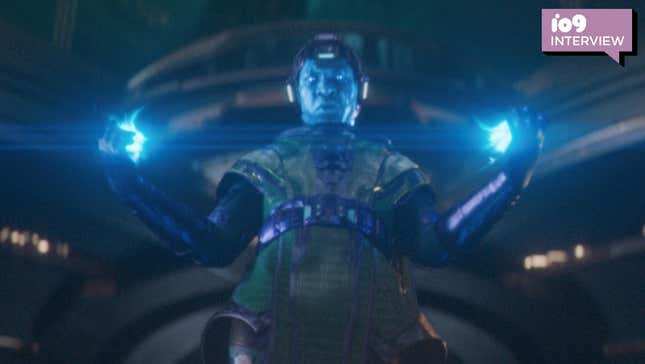
The Marvel Cinematic Universe has reached its turning point. After two years of introducing all sorts of characters and concepts, the upcoming release of Ant-Man and the Wasp: Quantumania should begin to put everything back into focus, and on a path that aims right at two more Avengers movies.
One of the people responsible for that path is Stephen Broussard. Broussard is a Marvel Studios executive on what’s referred to as the “Marvel Studios Parliament.” They’re the producers directly under studio heads Kevin Feige, Louis D’Esposito, and Victoria Alonso, who make sure the MCU keeps running smoothly. Members of the Parliament consult on every movie but then are also assigned to individually oversee specific movies or shows. For Broussard, his latest film is Ant-Man and the Wasp: Quantumania. (Previously, he did Iron Man 3, Doctor Strange, Loki, and Werewolf by Night, among others.)
io9 sat down with him to talk about how Quantumania came to be, how Kang became a part of it, Kang’s overall role in the future of the Marvel Cinematic Universe, and how the extremely busy Phase Four will help play into all of that.
This interview has been edited for length and clarity.
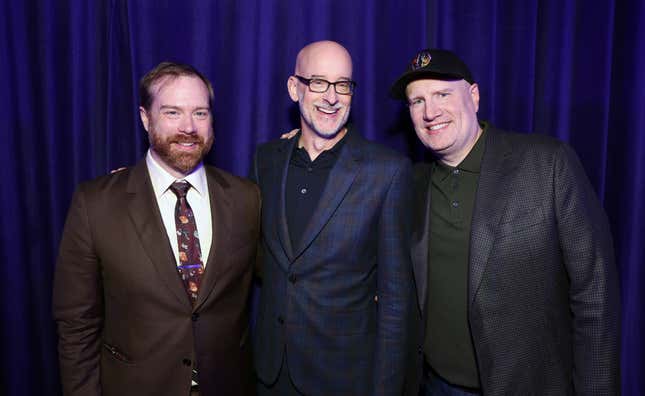
Germain Lussier, io9: I want to start by asking where the overall idea for this movie came from. Obviously, it’s not a traditional Peyton Reed movie, but then it’s also got to be this larger table-setter with a new villain—so I’m wondering, is this something Peyton pitched to Marvel or did Marvel decide this is something it wanted? Tell me a little bit about where it started.
Stephen Broussard: Yeah. The genesis of it, oddly enough, started about this point in the process on the last film, when the movie is done and we’re talking to people like yourself and we were happy with it. We were like, in part one, Hank asks if it’s possible to go down to the Quantum Realm. So there was this seed planted of part two could be about finding Janet. Similarly, what if the whole of part three was in the Quantum Realm? And we planted a seed, you’ve probably seen stories about a freeze-it moment of, like, a city, an architecture when they’re escaping [in part two]. That was us laying our marker down like, “Should we be so lucky as to come back from a part three, [we’ll explain this.]” So that was just Peyton and I geeking out a little bit.
And Peyton has very broad taste as a filmmaker. He has a very varied resume, but he’s a total sci-fi geek. He grew up on it and Planet of the Apes was very formative for him. We’ve talked a lot about that. And so there was kind of a Stranger in a Strange Land sense in this film, too, I think. I think he was excited to kind of tell a movie like that. And then we build it together and sort of figure out what it is from there.
io9: And was Kang always a part of it? Because now we know there’s The Kang Dynasty, Kang is in Loki, and this movie reveals a whole bunch more about him. How did he become a part of the film?

Broussard: He came later. So the first big idea was, what if it was all in the Quantum Realm? And the second big idea was, what if it felt like a bigger movie? While we love part one and part two—San Francisco crime-based smaller movies—another big idea with this was, what if it was this epic movie? You take these characters and drop them in a different kind of movie. And so if you’re going to do that, you need a big bad. A big person for them to go up against.
And as the universe started to take shape, some of the rules of the multiverse and, you know, the “science” of the multiverse, one of the big ideas was, as established in Endgame, that the Quantum Realm is like a conduit to other points in time. So the way I explain it to myself... that it’s kind of like the basement. The common basement of all the multiverse. So if there are these [Kang] variants and one of them needed to be banished, where could he go that could contain him outside of space and time, as Janet tells us? So it sort of felt like, “Okay, there’s a story here about why he might be down here, but he’s also formidable enough that he’s exciting.” And then from there, because of Jonathan [Majors], because of his performance, that’s where I think you start to see the future of the MCU. There’s a gravity to him, right? It’s not like “It’s going to be this, this, and this.” It really was the force of Jonathan, the gravity, and getting excited about that.
io9: Oh, totally. I just saw Magazine Dreams.
Broussard: I want to see it!
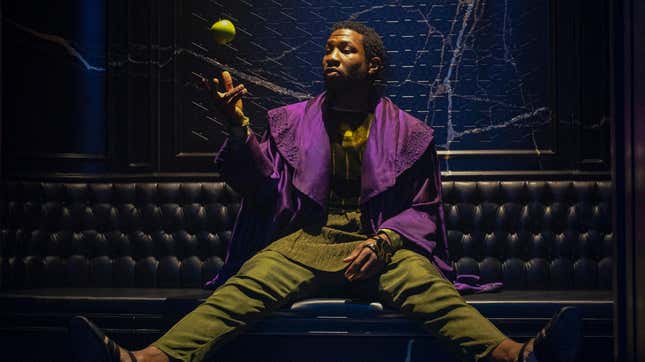
io9: Oh, he’s amazing in it. Sticking with Kang though, you produced Loki and that’s where he first debuted. So how did it work with having one version of the character there, another here, and how did the two impact each other?
Broussard: Well, in season one, He Who Remains is not necessarily—I believe this is correct, it’s been a minute—is not necessarily a Kang variant in the comics. But we liked the idea of it taking on a little bit of a pastiche of He Who Remains from the comics and Immortus, who went to the end of time and won. He kind of used his status to go there and look back through all of history from this privileged vantage point. So that was kind of like, “Well, what if it’s a version of Kang? What if it’s the same actor?” I was kind of playing go-between a little bit with Team Loki and Kate [Herron] and my colleagues on that and with Peyton. And there were dual casting calls where we were talking to everybody, making sure that everyone sort of has what they need from their own performance and their own version of the character. And it just starts to organically build from there about like, “Okay, well if it’s this in this film, then it can tie into the plot of this film a little bit.” But I want to hide that. That’s the scaffolding. That’s the sleight of hand. But there is a logic to all that and then you get a tease of [SPOILER REDACTED].
io9 : Yes, and I’ll be sure not to mention that before the movie comes out. What I can talk about though is the Quantum Realm. Assuming this is a place we might see again in some shape or form, is there any kind of larger Marvel approval process when creating a world or potential new destination for this universe?
Broussard: There’s not necessarily an approval process. It’s completely in the hands of the filmmaker and I get excited about that. If you look at the films I’ve made, I get excited about kicking down new doors. [Doctor] Strange was kicking down the door to magic. Werewolf by Night was about the horrorverse and feeling like going into this secret underbelly of Monsters in the MCU. The TVA [on Loki] is a whole new thing. So place as character is exciting to me.
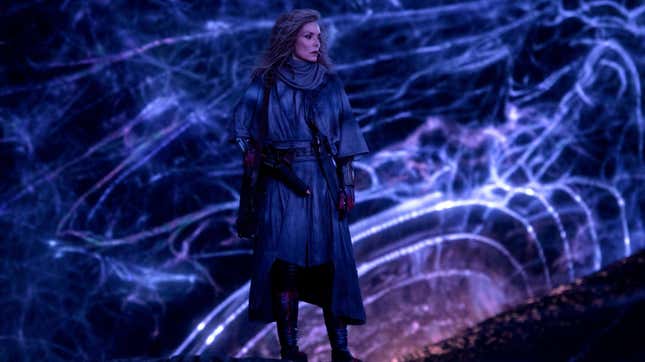
And that was our first big idea on Quantumania. In partnership with Peyton, it was really about saying what does that mean? I mean, obviously, Star Wars is going to loom large in anything you do in this space. So how does it not feel like that? How does it feel subatomic? How does it feel “quantum”? We used “quantum” as a verb ad nauseam behind the scenes. It’s just kind of asking that question at every turn and building it from a place that feels whimsical and lived-in and funny. There’s a fun tone to these movies that you may not necessarily get if we were shooting this in a different franchise, but that’s of this franchise and of Peyton.
io9: It sounds like the creation of this movie, and the MCU in general, can be kind of lucid to a point. So I’m curious, I don’t remember for sure, but when this movie was first announced, I don’t think it was called the first movie of Phase Five yet. I think that was revealed at Comic-Con. So I’m wondering when did that happen and once it does happen, does it add any new responsibilities?
Broussard: I’m trying to think of the exact moment. I think public facing it was it was probably Comic-Con. I don’t remember how far back it became official behind the scenes. I think when these larger narratives start to take shape organically there really is a philosophy here about interconnectivity. It’s fun, I love it too, and I know people get a kick out of it. But it’s meaningless if when you sit down with your popcorn to watch Quantumania, you don’t have a good time. So starting with Kevin, there is this philosophy about every story needing to matter and needs to be entertaining in and of itself. Throughout that process, organically, brick by brick, larger metanarratives start to coalesce and larger boundaries start to become clearer where it’s like, “Okay, this was part of this chapter of storytelling.” I liken it to trade paperbacks. Hardcover, trade paperbacks on my shelf. Again, we’re just blazing the trail the comic books have always have. Those start to come into shape but you can’t frontload that. And then once you make that decision for kicking off Phase Five and everything this film needs to do, by then you’re down the road on the film you’re going to make. So it’s not like you’re suddenly chasing some larger thing.
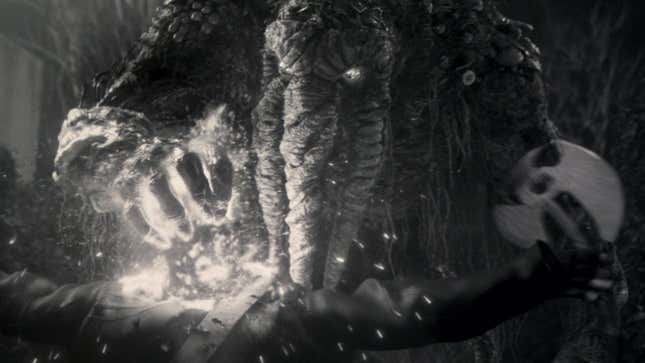
io9: Jumping off that, you mentioned that you worked on Werewolf By Night, which I thought was awesome, but to me is also the perfect example of how Phase Four felt very willy-nilly. Now it wasn’t, obviously. There are so many new concepts, so many new characters.
Broussard: Sure. Yeah.
io9: So what would you say to the fans who are looking at Phase Four, which I’ve been doing recently because we’re starting Five, and asking how is Marvel going to use all these pieces to make it all makes sense?
Broussard: Well, I think one of the meta-narratives of Phase Four was about new characters. It was about new people stepping into mantles. If you look at, like, Cassie [Lang in Quantumania] getting a suit and Kate Bishop [in Hawkeye], new characters being introduced like Jack in Werewolf by Night. After these first 10 years of Marvel storytelling, torches are being passed, like with Robert Downey Jr. no longer being [on the] table and stuff like that. So it was kind of like a new generation stepping to the forefront which, again, has always happened in the comics.
Some of those themes are on full display in the thematics of this movie, like what is the responsibility of the last generation? So I think Phase Four was about introducing all these amazing characters and getting the chance to tell these stories. Now that those players are on the board and there’s a big bad coming, it’s about like, “What are they going to do with that? What are they going to do with this power?” Because as you know, perhaps you’ve heard. with great power...
io9: [Laughs] Yes. “Comes great responsibility.”
Ant-Man and the Wasp: Quantumania kicks of Phase Five of the Marvel Cinematic Universe in theaters on February 17.
Want more io9 news? Check out when to expect the latest Marvel, Star Wars, and Star Trek releases, what’s next for the DC Universe on film and TV, and everything you need to know about the future of Doctor Who.

